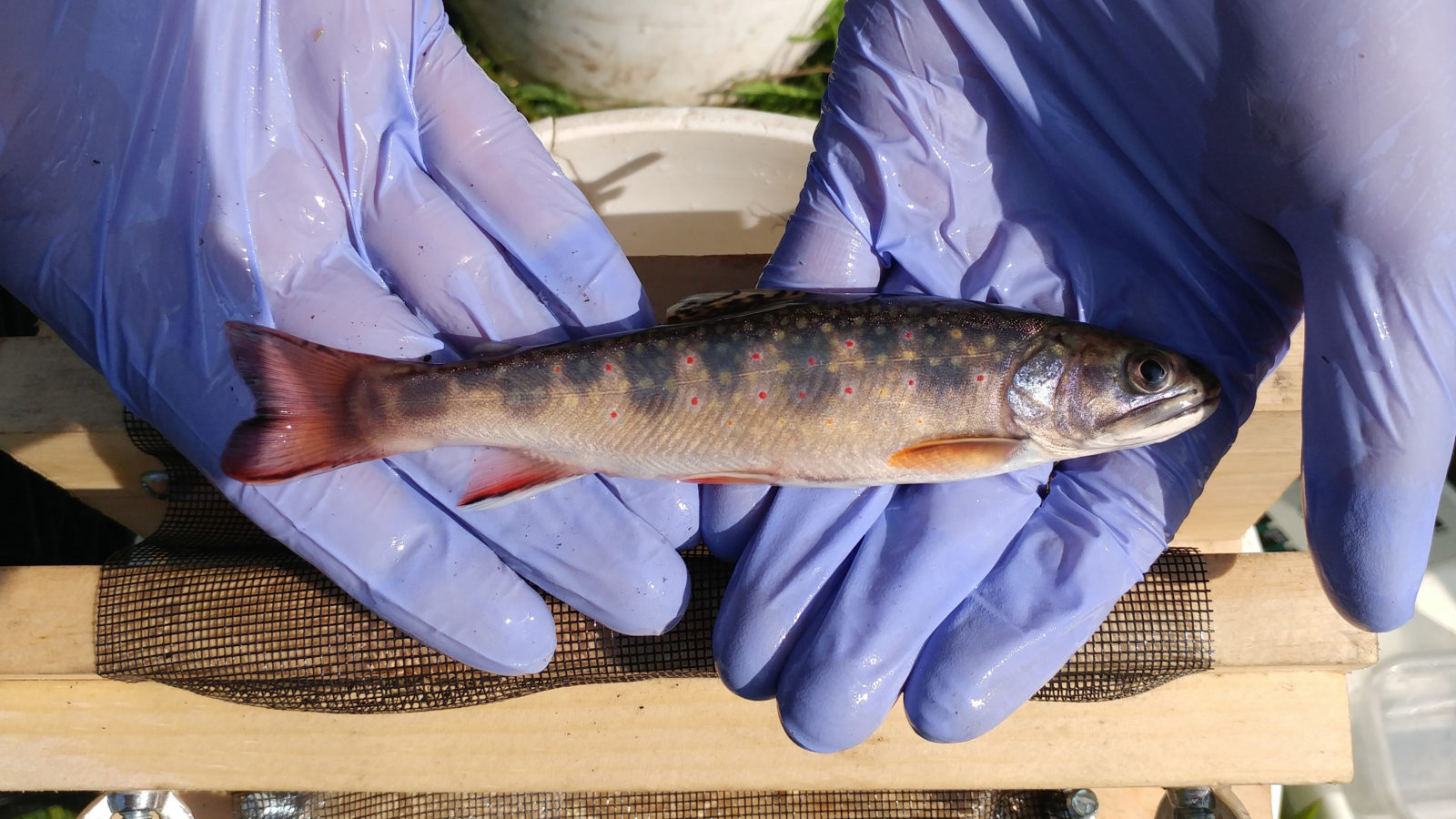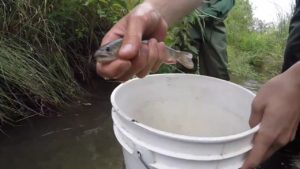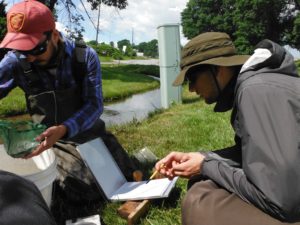A very exciting development has recently taken place that involves the Peterborough Field Naturalists: a partnership with Trent University to conduct a two year comprehensive study of the Brook Trout population in Harper Creek. As you know, Harper Park and the creek itself have been under threat from multiple developments in the catchment; the largest of which is the OLG casino and associated road developments. Harper Creek is unique in the city because it is a coldwater stream containing (at present) a healthy native Brook Trout population.
Please read on to learn about how YOU, your business, school or organization can partner with Trent University in this exciting local research.
Harper Creek Study: 20 Opportunities to Fund and Follow a Fish!
Update: All 20 fish have now been funded!
Thank you to the following donors!
- Cavan Chiropractic (Chiro)
- The Storey Family (Harper)
- The Electronics-Optronics Shop: Garrison Petawawa (Major Trout)
- Mark Guscott (Tessa)
- The Kelly/Dunlop Family (Sally)
- Limelight Advertising & Design – Peter Gabany (Brook)
- Dan & Nancy Mansell – AsiOtus Natural Heritage Consultants (AsiOtus)
- Fraser Bleasdale
- Shawn & Shannon Loughrey
- Alex Cable
- Richard MacPherson
- John McLean
- David Abbott
- Terry Hawkins
- Marilyn Hubley
- John Paul Benedict
- Sara Whitehead
- Jacob Bowman
- Heather MacPherson
- Brian Maxwell
Partner in local research by donating $200 to help cover the cost of a tag.
The Harper Creek Study will begin in the spring of 2017 with the tagging of 20 Brook Trout. Each trout will carry a radio tag that is less than one gram in size!
Fun fact: The generally recommended rule of thumb is that the radio tag should not exceed 2% of fish body weight.
The ratio of tag weight to fish weight, or tag burden, is designed to minimize impacts on the behaviour of the fish. A substantial portion of the weight of the radio tags is in the battery. The conundrum is that a bigger, heavier battery gives researchers more hours of data collection. For the Harper Creek Study, the team has decided to overcome limitations in battery size by having a tag designed that will shut off at night, thus extending the life of the battery. The Harper Creek research project is multifaceted using cutting edge, high tech science to learn about urban stream ecology in addition to opening a window into the life history of our resilient brook trout population, and you can be a part of it!
How can an individual, classroom, organization or business help to fund this study?
There are two ways to help fund the Harper Creek Study:
- you can fund an individual trout by covering the cost of it’s radio tag (please note that all 20 fish are now funded!); or
- you can direct your donation more broadly to the Harper Creek Study research effort.
Either way, your generosity will support innovative research in support of Brook Trout conservation.
Funding a fish connects you directly to an individual Brook Trout

By donating the cost of a radio tag, you will:
- receive a picture of the trout you are funding;
- information about your trout (gender, length, weight, unique traits);
- data about where, and when your funded trout moves within Harper Creek;
- receive your own copy of the published study on the Harper Creek wild brook trout population, and
- you can name your trout, but think of a male and female name as you won’t know the sex until you are paired with your trout, or choose a gender neutral name, but either way, have fun with it!. We will post your picture, and a picture of your trout on our About Your Trout page!
You will also have the satisfaction of knowing that your funding will help researchers reveal the hidden life history of the beautiful ‘Brookies’ in Harper Creek, a wild population about which little is known.
And, at a time when approximately 80% of the Brook Trout populations in Southern Ontario have disappeared, you will be helping the Trent University team gather information that could help conserve Brook Trout in other communities.
Can I also help to fund the study?
If all 20 fish are adopted, or you wish to donate to the research itself, the team would welcome funding of general expenses to help with essentials such as equipment, transportation costs and field staff.
How to use the Trent University Giving Page
- Click on the Donate to the Harper Creek Study button below.
- On the Trent University Giving page, select a preset donation, or select the blank donation box to enter your desired donation amount.
- Under the Designation dropdown menu, select the “Harper Creek Study”. Please note that as of May 1st, all of the 20 fish to be radio-tagged have been funded, and as a result, the Fund & Follow a Fish menu choice has been removed. But not to worry, there is a possibility that more fish will be tagged later as the study progresses through the seasons and you can still select the Harper Creek Study as a general donation to the research itself.
- Your tax receipt will be automatically generated and sent to the email address you have provided.
Donate to the Harper Creek Study
More about the Harper Creek Study

Did you know that the gene pool of the Harper Creek population is free from hatchery fish DNA and that this alone is a rarity! It is also unusual in that the brook trout have persisted in the creek despite industrial development, partial channelization of their habitat, storm sewer outflows in Harper Creek, destruction of beaver dams along the water course, and the dumping of fill into the stream bed. While there has been some monitoring of the population by PFN, DFO and various consultants, the population has never been systematically studied. This is unfortunate because we don’t know how it has reacted to the many changes wrought upon its habitat over the years, and because further developments along the stream (the casino in particular), are likely to subject the population to additional stressors such as increased turbidity, periods of artificial illumination, and salinity pulses from road maintenance in the winter.
The Harper Creek Brook Trout Study will commence in the spring of 2017, and continue until autumn 2018. The study will monitor seasonal movement and habitat use of the trout, using a combination of mark-recapture and radio tagging of individual fish. To help us understand the factors that affect habitat use, parameters such as water temperature, groundwater, salinity, suspended sediment and turbidity will be monitored, along with prey availability and the abundance of other fish species in the stream. All of this information will be used to create a habitat model for the brook trout in Harper Creek, as well as to identify the human impact factors that are, and will be affecting the trout. This information will allow us to identify the most valuable brook trout habitat in Harper Creek; project the potential impact of planned developments in the Harper Creek catchment on brook trout habitat loss without mitigation; and provide the necessary information to design mitigation measures to protect this valuable population.
The study will be conducted by Scott Blair, a graduate student under the supervision of Professor Michael Fox of the School of the Environment and the Biology Department at Trent University. Collaborators on the study include Professor Jim Buttle (Geography) and Dr. Lee Gutowsky (MNRF).
Community funding and support partners include the Peterborough Field Naturalists and the Ontario Federation of Anglers and Hunters.


